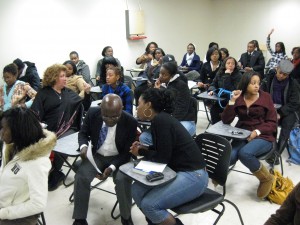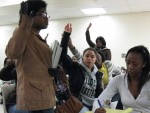 At the beginning of the Fall 2008 semester, I arrived on campus with the intention that the presidential campaign would be incorporated as part of my class assignments. Using the experiential learning model, I helped to organize the instructors and students in the Department of Journalism to cover the historic presidential election. We began the semester by immersing our students in the presidential campaign by assigning them to
At the beginning of the Fall 2008 semester, I arrived on campus with the intention that the presidential campaign would be incorporated as part of my class assignments. Using the experiential learning model, I helped to organize the instructors and students in the Department of Journalism to cover the historic presidential election. We began the semester by immersing our students in the presidential campaign by assigning them to  cover the September 2008 convention speeches of Sens. Barack Obama and John McCain as part of lessons on reporting on speeches. Immediately, we realized the opportunity presented by the historic election to give students hands-on experience covering the campaign, election and inauguration. Faculty members and adjuncts in the Department of Journalism, most former journalists, were eager to exploit the teaching opportunity that the election presented. We decided to treat the department as one, big news organization, bringing to bear all its resources to comprehensively cover an important breaking news story. The team successfully lobbied the department chairman and dean to excuse journalism students from class on Nov. 4 to cover the historic election.
cover the September 2008 convention speeches of Sens. Barack Obama and John McCain as part of lessons on reporting on speeches. Immediately, we realized the opportunity presented by the historic election to give students hands-on experience covering the campaign, election and inauguration. Faculty members and adjuncts in the Department of Journalism, most former journalists, were eager to exploit the teaching opportunity that the election presented. We decided to treat the department as one, big news organization, bringing to bear all its resources to comprehensively cover an important breaking news story. The team successfully lobbied the department chairman and dean to excuse journalism students from class on Nov. 4 to cover the historic election.
We decided that students would blanket the region (D.C., northern Virginia, Prince Georges County and Montgomery County) to write as well as capture video, audio and photos about the election. They were to report from polling sites locally and in their hometowns (which included such cities as New York, Chicago, Detroit). News coverage included up-to-the-minute reports on Election Day, as well as advance and follow-up pieces.
The challenge was to build a news operation from scratch. With little time for planning, the faculty members began by assessing the logistics of having students at all levels working as journalists. One veteran reporter and adjunct professor said that the journalism department would be mobilizing more people than most daily newspapers would have on the street on Election Day. I began by creating a story budget and asking students to contribute their ideas. We held a meeting at which more than 50 students attended.
Without prior experience coordinating such a large effort in the department, we began to assess equipment needs: desk telephones, laptops, digital and video cameras, tape recorders; staffing needs: Which students would be assigned as reporters and photographers; how to pair inexperienced students with experienced students? The faculty captured student cell phone numbers, e-mail addresses, and noted whether they had car insurance, what mode of transportation was being used. One student created a spreadsheet of polling stations. A faculty member compiled places to file stories, Wi-Fi stations and Metro stations for students who didn’t drive. Adjunct faculty members and other former journalists served as copy editors to staff the news desk along with some students.
Election story budget
Press coverage
I gave student crash courses in blogging, using Twitter, video uploading, and filing stories, much of it using Google’s free tools. The work also included building a mini-site for a Converged Election Project to provide stories for the black press (The site is currently unavailable because of host technical problems.) The team enlisted the assistance of the campus communications office to publicize the Converged Election Project.
On Election Day, nearly 100 students “flooded the zone” to work as professionals in a deadline-driven converged newsroom using multimedia tools. They worked in teams with students from all disciplines and at all levels. One student interviewed Mayor Adrian Fenty, another interviewed Congresswoman Donna Edwards, and several D.C. council members. They went to polling places in the District, Maryland and Virginia. Some went home to vote and covered the election there, sending back images and filing stories in real time. They started before dawn and worked until after midnight to witness the election of Barack Obama. In the end, they wrote more than 30 stories, produced more than 20 video packages published on YouTube and edited hundreds of photos for slideshows published in online campus publications.
Faculty members felt that student coverage of the election was so rewarding that they would also cover the inauguration. But planning for inauguration, with predictions that included crowds of up to 2 million and extremely tight security, meant the team had to consider that wireless transmission would be impaired as would be public transportation. Students would have to be resourceful as this event was a logistics challenge even for Washington, D.C.
Lessons learned from the previous coverage included making a better public relations effort to reach out to news organizations to let them know about our coverage. Planning began over the winter break. Part of the planning included applying to the Presidential Inauguration Committee, and other news agencies to get press credentials to give students access to some of the official events. The team was able to secure wireless cards for students to file from on location, and set up the converged media lab with more phones to allow students to file from the field if they could not get back in time. The department was able to secure a file server to give outside news organizations access to the stories covered. With an online operation, some editors deterred by heavy crowds were able to work virtually.
The faculty and nearly 50 students in Howard University Department of Journalism covered the inauguration of President Barack Obama, many working on four-person converged multimedia crews that took video cameras, still cameras and laptops to capture scenes from the inauguration, including Union Station, RFK Stadium, Memorial Bridge and the parade route. Operating like a professional news team with press credentials, the students started before dawn and throughout the day produced new items, including 22 print articles, 117 photos, 10 video packages and two audio packages for publications that included the Afro-American, the (N.J.) Trentonian.com, “Human Nature” online magazine and BlackAmericaWeb.com.
